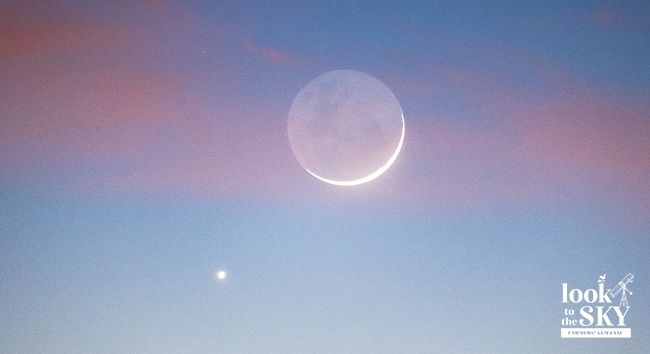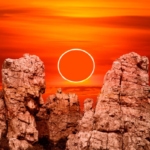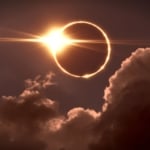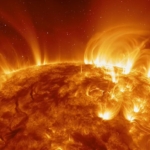April’s night sky highlights include the first full Moon of spring, many bright stars alongside the Moon, and a unique opportunity to catch an annual meteor shower that is normally too weak to see! Learn everything you need to know with our calendar of sky events here.
Do you have your “star binoculars” yet? How about a telescope? They are not required, but many sights are best seen with optical enhancement! Look for the telescope emoji – ? – as a quick reference for sky events where we particularly recommend them.
Bookmark this page now (Press command+D on your keyboard) so you can easily refer to it over the next few weeks. If you’re interested in locating particular planets in the sky throughout the year, take a look at our visible planets guide.
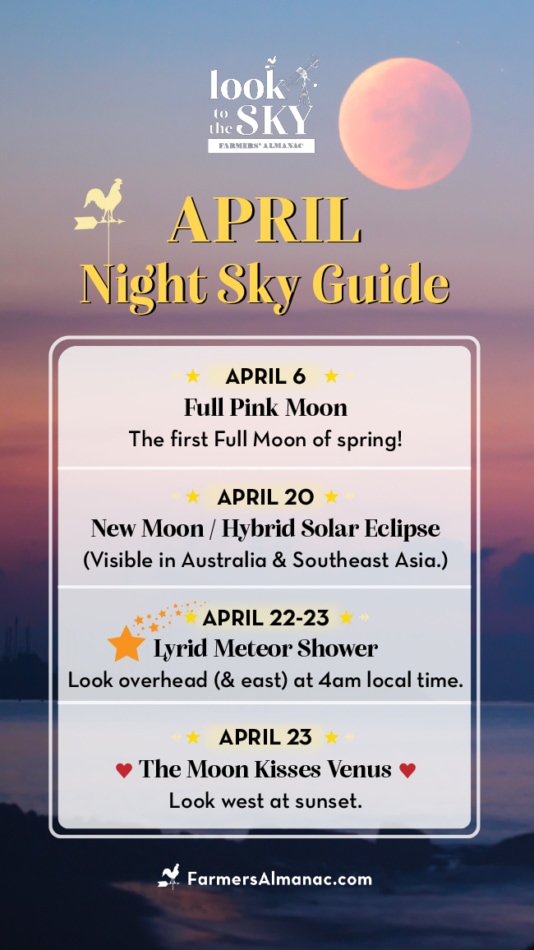
April Night Sky Guide
April 1 – Venus, Mars, And Red Stars
Venus dazzles at magnitude -4.1 for most of April. This silvery-white beacon climbs a little higher with each passing week, eventually appearing more than one third of the way up in the western sky at sunset. It lingers for for nearly two hours after sunset and outshines anything else — except for the Moon. (The interval between sunset and Venus-set increases to about three and one half hours over the course of April.)
Later this evening, at approximately 9pm local time, look west to see Mars. The “red” planet lies almost midway between two reddish stars of similar brightness: Pollux (above) and Aldebaran (below). Compare their colors with your naked eye. According to the astronomer’s measure of redness, Pollux has a “color index” of 1.0 and Aldebaran is a deeper orange, 1.5. Where would you place Mars on this scale?
April 6 – Full Pink Moon
The Full Pink Moon reaches peak illumination at 12:34 a.m. EDT. Why is it called the Full Pink Moon? No, it’s not because the Moon is actually pink in color. It’s named after the first flowers to emerge in spring! Learn more in the video below and discover alternative names and folklore here.
This is the first full Moon of spring, the so-called Paschal Moon. Ecclesiastical rules mandate that the first Sunday after this Moon is Easter, and so it will be on the 9th.
April 9-10 — The Moon And Antares
If you look low to the southeast horizon after 12:30 a.m. local time, you’ll see the 82% illuminated waning gibbous Moon, rising with the bright reddish star Antares hovering less than a degree below it. In the hours that follow, take note that the Moon slowly drifts away to the east (left) of the star at the distance of its own diameter each hour.
April 10 — Venus With The Pleiades
? About 90 minutes after sunset, Venus passes approximately two degrees south (lower left) of the Pleiades — an alluring sight in binoculars!
April 11 – Venus And Mercury
Look west-north-west at sunset to see Venus shining brightly approximately 30 degrees above the horizon. If you are in a location that doesn’t have many trees or buildings, you will find Mercury below it. This will be Mercury’s best showing all year (for mid-northern observers) as the planet reaches its greatest elongation, 19 degrees east of the Sun.
Mercury sets just after twilight ends, against a completely dark sky. Note, however, that over a span of two weeks – from April 4-18 – this capricious planet rapidly fades eight-fold, from magnitude -0.8 to +1.5. It will be difficult to spot without binoculars after mid-April. Mercury will seem to disappear into the light of the Sun during Inferior conjunction on May 1st.
April 13 – Last Quarter Moon
The last quarter Moon occurs at 5:11 a.m. EDT.
April 14 – Mars And Epsilon (in Gemini)
? An interesting eye test will be provided this evening by the very close approach of Mars to the star Epsilon Geminorum, formally named Mebsuta, in the constellation Gemini.
Mars currently shines at magnitude +1.2. Mebsuta appears only 1/6 as bright at +3.1. From the Eastern US the two will be separated by only 12 arc minutes or four-tenths of the apparent width of the Moon; from the West Coast the gap will have widened to 15 arc minutes. With good eyesight, you should be able to split them. If not, use binoculars.
April 16 – The Moon And Saturn
Look low toward the east-southeast horizon about 90 minutes before sunrise this morning and you’ll see a 20% illuminated crescent Moon. Saturn will be hovering about five degrees above it.
The ringed planet, in Aquarius, rises in the southeast during early predawn twilight during the first week of April, but in late-night darkness during the rest of the month.
April 20 – New Moon And “Hybrid” Solar Eclipse
The new Moon is at 12:13 a.m. EDT. Also, a rare “hybrid” solar eclipse occurs.
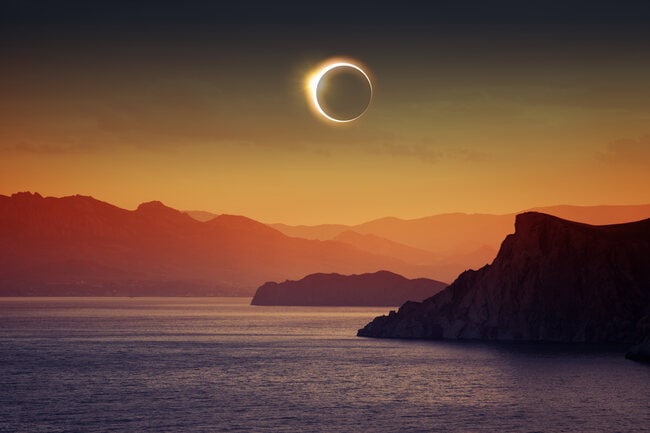
When speaking of eclipses of the Sun, there are three basic types:
- Partial eclipse: Part of the Sun is covered by the Moon. In this case, only outer shadow of the Moon (penumbra) lands on the Earth.
- Total eclipse: The Moon completely blocks the Sun’s disk and casts a dark shadow cone (umbra) over specific areas on Earth. Only within direct line of sight (the path of totality) may witness the beauty of this awe-striking event.
- Annular eclipse: When the Moon covers the Sun but the Moon is too small (not close enough to the Earth) to cover the complete disk of the Sun and therefore creates a “ring of fire” effect. A circle of Sunlight remains visible around the edge of the Moon. (The next annual eclipse for North America occurs in October 2023.)
However, there is a fourth type of solar eclipse, known as an annular-total or “hybrid” eclipse — the rarest variety of all. As the name implies, hybrids transition from one form to another over the course of the eclipse duration. For instance, on April 20th, the Moon’s shadow merely scrapes the surface of the Earth in northeast across Indonesia, creating an annual “ring of fire” effect. But about a minute later the umbra of the Moon touches down on the Earth’s surface and the eclipse transitions to “total.”
First landfall is North West Cape, a peninsula in Western Australia. From Cape Range National Park, the Sun is totally eclipsed for 63 seconds. The point of greatest eclipse is attained in the Timor Sea, just south of Timor-Leste, in Southeast Asia. Here, the Sun will be totally eclipsed for 76.1 seconds at an altitude of 67 degrees, but the eclipse path is only 30 miles wide. Continuing northeast, it cuts through West Papua, New Guinea and then turns east, narrowly missing the tiny island of Kosrae of Micronesia.
Hybrid eclipses account for only 4.8% of all solar eclipses. In the 21st century, only seven such eclipses will take place.
Learn more about eclipses, including when the next ones will occur!
April 21 – Crescent Moon – A Gorgeous Sliver In The Twilight Sky
About 30 minutes after sundown, scan the western horizon with binoculars and see if you can pick up an exceedingly thin crescent Moon, only 20 to 23 hours past “new” and only about one percent illuminated by the Sun.
April 22 – Mars And Gemini
Mars forms a long isosceles triangle high in the west-southwest sky with Gemini (Castor and Pollux) this evening. Mars marks the vertex of the triangle and lies 10 degrees from each. The red planet continues to fade and shrink as it continues to speed eastward through Gemini.
April 22-23 – Lyrid Meteor Shower
Conditions are good this year for the Lyrid meteors, since the Moon is three days old and absent from the night sky when the shower reaches maximum in the predawn hours on the morning of April 23rd. We recommend bundling up and lying flat on your back, facing eastward at approximately 4am.
Lyrid meteors appear to emanate from the bright star Vega. Usually, the shower is weak, with only about 10 per hour visible under ideal conditions – roughly the rate of sporadic meteors. But surprises do occur. In 1982 rates of well over 75 Lyrids per hour were recorded for brief periods. The shower is at one-quarter peak strength a day or two before and after maximum.
April 23 — The Moon Kisses Venus
After sunset, face due west to get a view of a lovely crescent Moon, hanging nearly 5 degrees above Venus. Although they are rather widely separated, they still make for a striking sight in our early evening sky. Note also, the unilluminated portion of the Moon dimly lit by Earthshine. (See the featured image for this page as a reference for what it may look like!)
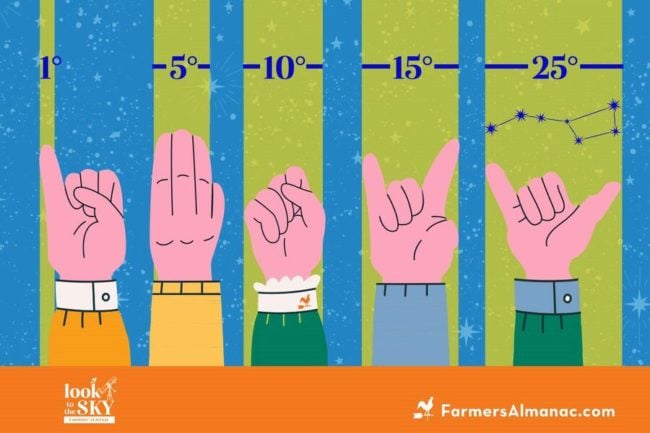
April 24 – Scope It Out: The “Beehive” Star Cluster (in Cancer) In The Night Sky
? Look southwest during the mid-evening hours to discover one of the brightest galactic star clusters, situated within the humble constellation Cancer. 1,000 stars exist in this cluster, more than 100 of which can be seen with binoculars or a telescope.
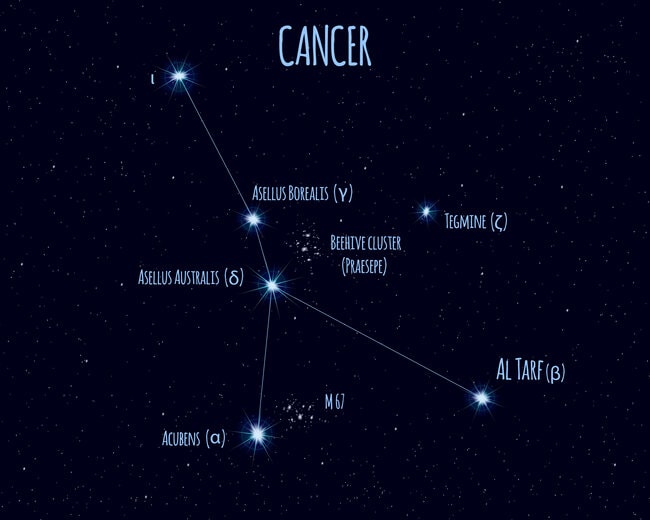
Some astronomy texts call this cluster “Praesepe, the Manger,” while others call it the “Beehive.” A manger is defined as “a trough in which feed for donkeys is placed.” The cluster was first called Praesepe 20 centuries ago and relates to two stars in the middle of Cancer known as the “donkeys” (Asellus Borealis and Asellus Australis) that seem to eat from it.
The cluster’s relatively new moniker – “Beehive” – apparently evolved more than four centuries ago, when some anonymous person, upon seeing so many stars revealed in one of the first crude telescopes exclaimed: “It looks just like a swarm of bees!” Hence, the reason for why some astronomy books call the cluster “Beehive,” while others call it “Praesepe.”
Note: This cluster is fairly faint and requires a dark sky for proper viewing.
April 25 – The Moon And Mars
This evening, the Moon will pass about 3 degrees to the upper right of Mars. Mars is getting so far from Earth that in most telescopes it is just a tiny orange blob and has now faded to magnitude +1.3 (about 1/19 as bright as it appeared last December). Congratulate yourself if you can detect any surface features on it at all with a telescope. You shouldn’t have trouble noting its gibbous phase, however.
April 27 – First Quarter Moon
The first quarter Moon occurs at 5:20 p.m. EDT.
Learn how to align your intentions with the phases of the Moon.
April 30 – Jupiter Becomes A Morning Star
? Look east about thirty minutes before sunrise to see Jupiter. This bright planet at magnitude -2.1 is readily visible with binoculars.
Jupiter passed through conjunction, disappearing from view on the far side of the Sun, on April 11th and emerged on the eastern horizon by the beginning of the third week of the month, but remained too low for observers at mid-northern latitudes to see it — without the use of an optical aid.
Join The Discussion!
What sky event are you looking forward to in April’s night sky?
Share your excitement with your community here in the comments below!
Related Articles
Full Moon April 2023 – Pink Moon And Alternative Names

Joe Rao
Joe Rao is an esteemed astronomer who writes for Space.com, Sky & Telescope, and Natural History Magazine. Mr. Rao is a regular contributor to the Farmers' Almanac and serves as an associate lecturer for the Hayden Planetarium in New York City.

